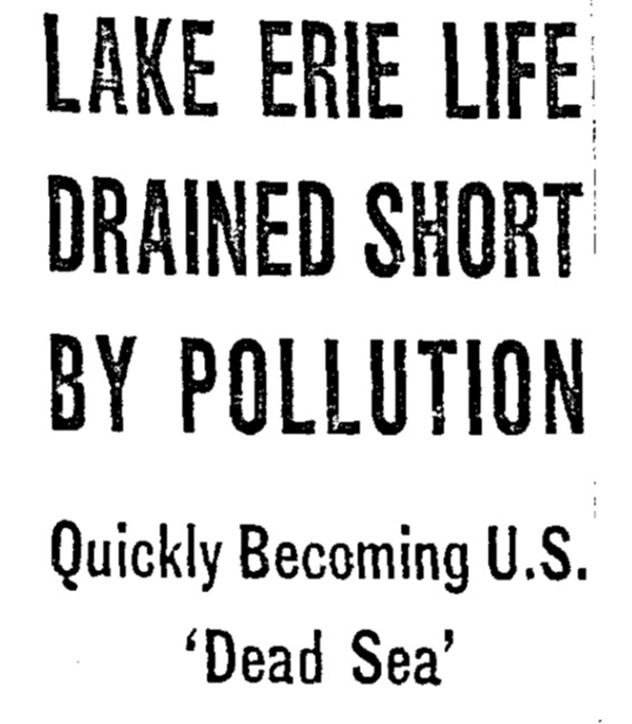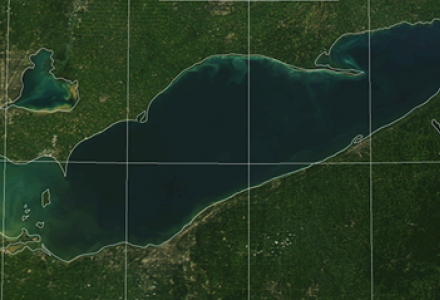
Over the past two centuries, western settlement and the Industrial Revolution dramatically changed the water quality of the Great Lakes. New economic activities and cultural centers were spawned, while the lakes saw new (and often unwanted) species and pollution from industry, agriculture and cities.
The 1972 Great Lakes Water Quality Agreement provided a path forward for Canada and the United States to jointly address these issues. The two nations have made much progress in the years since. April 15 marked the 50th anniversary of the Agreement’s signing.
But the Agreement was not the start of efforts to restore the lakes. Since its inception in 1909, the International Joint Commission (IJC) has been involved in Great Lakes water quality issues. Article IV of the Boundary Waters Treaty states that all transboundary waters “shall not be polluted on either side to the injury of health or property on the other.” Within that scope (more limited than the Agreement as a whole), governments tasked the IJC several times prior to the Agreement to assess the Great Lakes and make recommendations.
The 1910s Water Quality Study
The IJC’s first Great Lakes water quality assessment started in 1913 and published its final report in 1918. The governments of Canada and the United States specifically asked the IJC to study the location and extent of pollution in all boundary waters including the Great Lakes. The IJC was to find the sources of pollution, and determine whether the sources impacted the other country, as well as make recommendations to prevent further pollution issues. At the time, the primary focus in the Great Lakes was on bacterial contamination from sewage systems across the region and from ships, with samples taken near major cities and connecting channels.
In most cases, the IJC found contaminated water around Great Lakes cities and towns, particularly where ships were frequently located.

The Detroit River, circa 1915. Credit: Library of Congress
The report identified the Detroit River and lower Niagara River as particularly unsuitable for household use due to bacterial contamination from the cities of Detroit and Buffalo, which affected residents in both countries.
Overall, the IJC pointed to raw, untreated sewage being dumped into the lakes as the cause behind typhoid fever outbreaks in the region. Ultimately, the IJC recommended an end to dumping untreated sewage into rivers and lakes, that water purification be used for public drinking supply systems, that ships begin sterilizing sewage before dumping it, and that ballast water exchange near water intakes be limited.
While the 1918 report notes pollution from industrial and chemical sources, it was at that time considered limited and local, and therefore outside the scope of the request from the two governments. The IJC wrote in its report that “unless preventative measures are taken, pollution from these wastes will have a very injurious effect,” and suggested the governments look into the issue further and consider new regulations. The IJC would later write in a 1961 document that government efforts to address these issues fell by the wayside due to preoccupation with World War I.
Newfound Interest in Pollution Mid-Century
From 1913 to 1946, industrial pollution continued to worsen in the region as the population around the lakes exploded and industry rapidly expanded.
In the mid-20th century, Canada and the United States began passing new laws to contend with a variety of pollution types, spurred by worsening environmental conditions and scientific reporting on the damage to wildlife, habitats and people. In 1948, the US government passed the Federal Water Pollution Act, its first major law addressing water contamination.
In 1946 and 1948, Canada and the United States approved the formation of the IJC Lakes Superior-Huron-Erie Advisory Board and the Lakes Erie-Ontario Advisory Board. The IJC tasked each board with monitoring pollution in connecting channels of the Great Lakes. The boards focused on industrial and chemical pollution, an issue that had only worsened since the 1918 report.
From 1946 to 1950, a second transboundary pollution study looked at sewage, chemical and industrial pollution, as well as contamination from channel dredging and ship waste. It found that the Great Lakes’ connecting channels, rivers and Lake St. Clair were polluted contrary to the treaty’s requirements and laid out recommendations on how to remediate the damage, along with recommended objectives for limiting pollutants.

Lake Okonoka, on Belle Isle in the Detroit River, was cut off from the river system in the 1950s. A project, completed in 2020, restored that connection. Credit: Friends of the Detroit River/EPA
The IJC produced an additional document in 1961, “Safeguarding Boundary Water Quality,” covering progress made since the 1950s. Between 1948 and 1959, there was a substantial drop in the volume of oils and phenolic compounds discharged into the Great Lakes , while cyanide chemicals and suspended solids fell to about half of their 1948 amounts. Further, cities were constructing new municipal water treatment plants across the region to address bacterial contamination.
The Final Pre-Agreement Years and the First Assessment
By the late 1960s, environmental concerns were peaking in both countries. National media declared the Cuyahoga River and Lake Erie as “dead” due to excessive nutrients and a lack of oxygen, which spurred government action.

Headline from the Chicago Tribune, Aug. 25, 1967. Credit: Give Earth a Chance: Environmental Activism in Michigan
In the United States, Congress passed significant amendments to the Clean Air Act and Clean Water Act, and in 1970 President Richard Nixon created the Environmental Protection Agency to oversee enforcement of these historic laws.
In Canada, the 1971 Department of Environment Act created Environment Canada, while the Canada Water Act spelled out responsibilities between the provinces and federal government for the use and conservation of water. Cities constructed or upgraded their sewage systems to meet requirements under the 1971 Canada-Ontario Agreement on Great Lakes Water Quality and Ecosystem Health.
Finally in 1972, both countries signed the first Great Lakes Water Quality Agreement, a binational policy mechanism focused on reducing phosphorus loadings and visible pollution. The Agreement called for the creation of an IJC Great Lakes Regional Office to help manage the activities of the newly established Great Lakes Water Quality Board.

The Cuyahoga River on fire in 1952. Credit: Cleveland Press Collection/Cleveland State University
In 1973, the IJC Great Lakes Water Quality Board submitted its first report assessing water quality across the lakes. It found that Lake Superior had good water quality overall, except for localized areas (notably around Silver Bay, Minnesota), with a similar story for Lake Huron save for Saginaw Bay, where the Saginaw River was a source of chemical contaminants.
Lake Michigan had issues with chemical contamination in aquatic life in the southern and middle regions of the lake, while Erie suffered from algal blooms and low-oxygen conditions. Lake Ontario suffered from nutrient pollution along the nearshore, primarily around Toronto, Hamilton, St. Catharines and Rochester. Finally, pollution discharged into connecting channels continued to be a problem, just as it was in the 1910s.
On a finer scale, industrial pollution control was underway by 1973, with regulations and court proceedings forcing movement on some of the key issues. New regulations removing phosphorus from detergents and widespread nutrient controls reduced algal blooms and low-oxygen zones in the lakes, and new legislation in both countries reduced pesticides entering the lakes. Regulations to manage shipboard waste disposal also were in development in the United States and expected to be in force by the mid-1970s, with Canada considering similar actions.
A key part of controlling shipboard waste came from the International Convention for the Prevention of Pollution from Ships, signed in 1973, which imposed a global ban on discharging oil-contaminated substances from vessels within 50 miles of land and limited discharges elsewhere. In the Great Lakes, Canada and the United States required ships to segregate ballast tanks to avoid oil contamination and to install oily water separators in engine rooms. These requirements would be factored into the Great Lakes Water Quality Agreement in 1972 and expanded upon in later updates.
In 1971, the Detroit and Niagara rivers remained among the most polluted areas of the Great Lakes.
A 1971 IJC summary report of cleanup work performed in the Niagara River since 1967 found that, while the Canadian side of the upper river had overall good water quality, the rest suffered from excessive contaminants. That said, the IJC found that governments were making progress, with municipalities upgrading and building water treatment plants on both sides of the river and industrial sites constructing their own treatment systems--albeit not always within the timetables laid out by New York and Ontario. The Water Quality Board revisited this issue in a 1973 report which indicated that lagging timetables were still an issue.
Meanwhile, the Detroit River had considerable industrial contamination and sewage entering from the Detroit area (and to a lesser extent Windsor) even though the upper 10 miles of the river north of both cities were in relatively good shape. In 1971, Detroit was getting its wastewater under control as new facilities came online.
Great Lakes Water Quality Today
The Great Lakes are in significantly better shape today. he IJC and governments have identified numerous challenges still facing the waters—such as climate change, nutrient pollution, invasive species and chemicals—but continued cleanup efforts and regulations have made a visible difference. In recent years, the US Great Lakes Restoration Initiative and Canadian Great Lakes Protection Initiative increased funding that is substantially accelerating work to protect, restore and enhance the lakes’ water quality.
Decades of pollution put the Great Lakes in their sorry state by the time Canada and the United States signed the first Great Lakes Water Quality Agreement; And it will take decades more to repair this legacy of damage. But it is noteworthy that for more than a century the IJC conducted studies and assisted governments to help improve the lakes’ water quality. The IJC remains ready, willing and able to continue this effort under the Great Lakes Water Quality Agreement into the next 50 years and beyond.

The Mean Deviation Ratio of pollution in the Great Lakes basin as measured from fish contamination. In this instance, negative numbers indicate higher water quality. Credit: Environment and Climate Change Canada/Environmental Protection Agency/State of the Great Lakes 2019 Technical Report

Kevin Bunch is a writer-communications specialist at the IJC’s US Section office in Washington, D.C.



